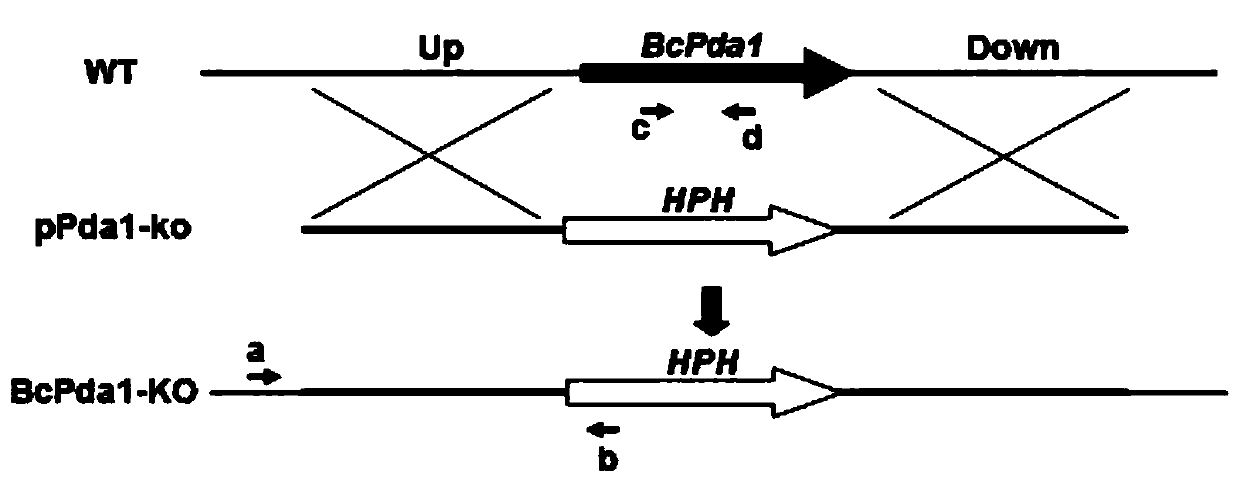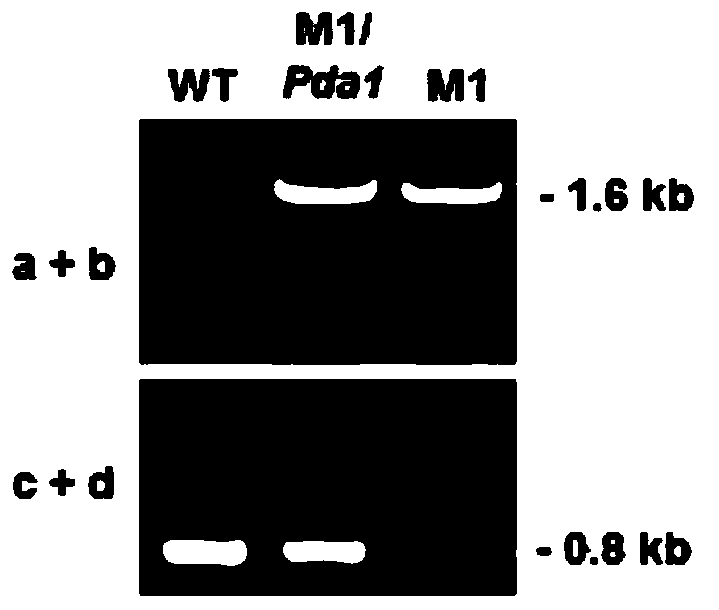A Botrytis cinerea gene bcpda1 related to pathogenicity and its application
A technology of Botrytis cinerea and genes, applied in the application field of genes and their encoded proteins, can solve the problems such as little knowledge of molecular mechanisms
- Summary
- Abstract
- Description
- Claims
- Application Information
AI Technical Summary
Problems solved by technology
Method used
Image
Examples
Embodiment 1
[0023] Example 1 Correlation analysis of BcPda1 gene
[0024] The open reading frame of BcPda1 gene of Botrytis cinerea consists of 1140 nucleotides, only contains one exon (no intron), and the encoded protein product consists of 379 amino acids. The BcPda1 protein sequence was compared and analyzed (http: / / blast.ncbi.nlm.nih.gov / Blast.cgi), and it was found that Pda1 widely exists in cellular organisms such as animals, plants, fungi and bacteria. Domain analysis revealed that the BcPda1 protein contains a conserved porphobilinogen deaminase domain (see figure 1 ).
Embodiment 2
[0025] Example 2 Knockout of BcPda1 Gene
[0026] 1) Construction of knockout vector
[0027] Primer Pda1-UP-F(5'- GAATTC CGGCTTCCATTTCTGCTAC-3') and Pda1-UP-R(5'- GGTACC CACAACCACGACCAACCAT-3'), using the genomic DNA of Botrytis cinerea strain B05.10 as a template to amplify the 762bp fragment upstream of the BcPda1 gene, using Pda1-DN-F (5'- TCTAGA TTCACAGGCACATAGGCTACA-3') and Pda1-DN-R(5'- CTGCAG ACTTTGGAATACTCACCTTTATCACT-3') to amplify the downstream 793bp fragment of Botrytis cinerea BcPda1 gene, the reaction system is: 10mmol / L dNTP Mixture, 0.5μL; 10×PCR buffer, 2.5μL; each 1μL of upstream and downstream primers (10μmol / mL); template DNA , 1μL; Ex-Taq, 0.2μL (5U); ddH 2 O, 18.8 μL; amplification program: 94°C pre-denaturation for 3 minutes, then (1) 94°C, denaturation for 50 seconds; (2) 58°C, annealing for 50 seconds; (3) 72°C, extension for 60 seconds; (4) ) cycled 30 times; (5) extended at 72°C for 10 minutes. The above two DNA amplification products were...
Embodiment 3
[0037] Example 3 Genetic Complementation of BcPda1 Gene Deletion Mutants
[0038] Primers C-F (5'-GAATTCCGGCTTCCATTTCTGCTAC-3') and C-R (5'-CTGCAGACTTTGGAATACTCACCTTTATCACT-3') were used to amplify the full-length 2968bp gene of Botrytis cinerea BcPda1 (including promoter, open reading frame and terminator), and cloned into pMD18-t vector, and then subcloned into the pSULF vector (containing chlorimuron-methyl resistance gene) between the EcoR I and Pst I sites to construct a genetic complementation vector pPda1-ko-c. The vector was verified by sequencing to confirm that there were no amino acid mutations. Using the Agrobacterium-mediated transformation method as described above, 100 μg / mL chlorimuron-methyl was used for screening, and the complementary fragment was transferred into the genome of the BcPda1 gene deletion mutant M1 to obtain a genetically complementary strain M1 / Pda1. The primers a and b, c and d used in the mutant verification were selected for PCR amplificat...
PUM
 Login to View More
Login to View More Abstract
Description
Claims
Application Information
 Login to View More
Login to View More - R&D
- Intellectual Property
- Life Sciences
- Materials
- Tech Scout
- Unparalleled Data Quality
- Higher Quality Content
- 60% Fewer Hallucinations
Browse by: Latest US Patents, China's latest patents, Technical Efficacy Thesaurus, Application Domain, Technology Topic, Popular Technical Reports.
© 2025 PatSnap. All rights reserved.Legal|Privacy policy|Modern Slavery Act Transparency Statement|Sitemap|About US| Contact US: help@patsnap.com



